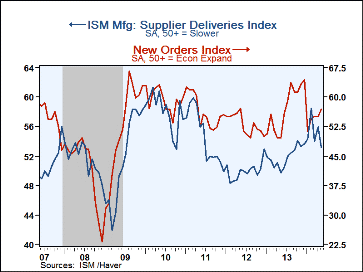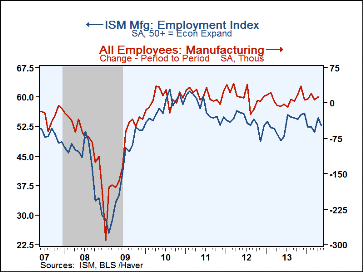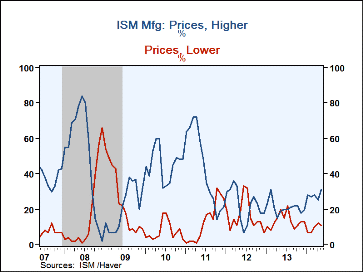 Global| Jun 02 2014
Global| Jun 02 2014U.S. ISM Index Backpedals But Prices Strengthen
by:Tom Moeller
|in:Economy in Brief
Summary
The Composite Index of Manufacturing Sector Activity from the Institute for Supply Management fell back to 53.2 during May from an unrevised 54.9 in April. The reading retraced two months of improvement and was below the November peak [...]
The Composite Index of Manufacturing Sector Activity from the Institute for Supply Management fell back to 53.2 during May from an unrevised 54.9 in April. The reading retraced two months of improvement and was below the November peak of 57.0. The latest figure disappointed consensus expectations for 55.5 as measured by the Action Economics Forecast Survey. Any figure above 50 indicates an increasing level of factory sector activity. During the last ten years, there has been a 76% correlation between the ISM index and the q/q change in real GDP.
Four of the five component series fell m/m. The largest decline occurred in the supplier delivery index indicating the quickest product delivery speeds in nine months. That deterioration was followed by the employment series which retraced most of its April improvement. During the last ten years there has been an 88% correlation between the employment index and the m/m change in factory payrolls. The new orders index fell to its lowest level since January while the production figure slipped modestly. The inventory index was unchanged at the highest level since August 2012.
The export order series fell modestly but remained up sharply versus twelve months ago while the import index fell sharply, reversing its July jump. Order backlogs fell to the lowest level in three months.
The prices paid index series improved and recovered two months of decline. Thirty one percent of firms raised prices while eleven percent lowered them. During the last ten years, there has been a 67% correlation between the index and the m/m change in the intermediate producer price index.
The figures from the Institute For Supply Management (ISM) are diffusion indexes and can be found in Haver's USECON database. The expectations number is in the AS1REPNA database.
Just Released: What Kinds of Jobs Have Been Created during the Recovery? from the Federal Reserve Bank of New York can be found here.
| ISM Mfg | May | Apr | Mar | May'13 | 2013 | 2012 | 2011 |
|---|---|---|---|---|---|---|---|
| Composite Index | 53.2 | 54.9 | 53.7 | 50.0 | 53.9 | 51.8 | 55.2 |
| New Orders | 53.3 | 55.1 | 55.1 | 49.6 | 57.2 | 53.1 | 56.4 |
| Production | 55.2 | 55.7 | 55.9 | 52.5 | 57.7 | 53.8 | 57.4 |
| Employment | 51.9 | 54.7 | 51.1 | 49.0 | 53.2 | 53.8 | 57.4 |
| Supplier Deliveries | 52.5 | 55.9 | 54.0 | 49.7 | 51.9 | 50.0 | 54.7 |
| Inventories | 53.0 | 53.0 | 52.5 | 49.0 | 49.4 | 48.2 | 50.1 |
| Prices Paid Index (NSA) | 60.0 | 56.5 | 59.0 | 49.5 | 53.8 | 53.2 | 65.2 |
Tom Moeller
AuthorMore in Author Profile »Prior to joining Haver Analytics in 2000, Mr. Moeller worked as the Economist at Chancellor Capital Management from 1985 to 1999. There, he developed comprehensive economic forecasts and interpreted economic data for equity and fixed income portfolio managers. Also at Chancellor, Mr. Moeller worked as an equity analyst and was responsible for researching and rating companies in the economically sensitive automobile and housing industries for investment in Chancellor’s equity portfolio. Prior to joining Chancellor, Mr. Moeller was an Economist at Citibank from 1979 to 1984. He also analyzed pricing behavior in the metals industry for the Council on Wage and Price Stability in Washington, D.C. In 1999, Mr. Moeller received the award for most accurate forecast from the Forecasters' Club of New York. From 1990 to 1992 he was President of the New York Association for Business Economists. Mr. Moeller earned an M.B.A. in Finance from Fordham University, where he graduated in 1987. He holds a Bachelor of Arts in Economics from George Washington University.










